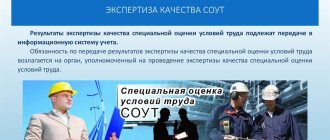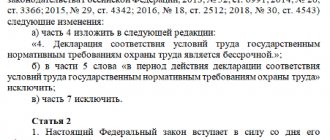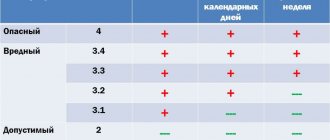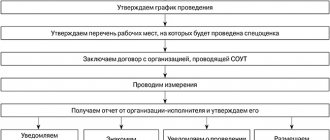Methodology for carrying out SOUT
The procedure for conducting a special assessment of working conditions is set out in the methodology for conducting special assessments, which was approved by Order of the Ministry of Labor dated January 24, 2014 No. 33n and is a mandatory procedure that consists of the following stages:
- identification;
- analysis of identified harmful factors;
- classification of the workplace based on the results of the study;
- drawing up a conclusion.
A special assessment of working conditions is not carried out in relation to:
- homeworkers;
- remote workers and workers who have entered into employment contracts with employers who are not legal entities.
Methodology for conducting SOUT “Order of the Ministry of Labor of Russia No. 33 dated January 24, 2014” - presentation
In addition, based on the results of a special assessment of working conditions, the amount of various compensations to the employee for harmful (dangerous) conditions will be established: increased wages, additional leave, reduced working hours, early retirement.
According to the law, a special assessment must be carried out at least once every five years. At the same time, the previously existing certification of workplaces was also carried out once every five years. The Ministry of Labor explains: if five years have not passed since the certification according to the old rules, then its results are valid until the expiration date. However, if during this time the employer has improved working conditions and reduced the impact of harmful (hazardous) factors, it makes sense for him to carry out an early special assessment at the improved workplaces and save on contributions to the Pension Fund and on employee compensation.
Let us remind you that since last year, employers began making additional contributions to the Pension Fund for workers working in hazardous conditions on the first and second lists. Since 2014, tariffs have increased: for list 1 - to 6 percent, for list 2 - to 4 percent. And from 2015, tariffs will be 9 and 6 percent, respectively. But if working conditions improve, you will not have to pay additional contributions.
"Russian newspaper"
" All news
The introduction of a special assessment of working conditions (SOUT) made it possible to optimize the labor process and facilitate laboratory control. However, few are fully aware of this issue, especially the nuances of organizing and conducting assessments. Let's try to clarify the situation.
The implementation of SOUT was approved by law in 2013-2014, and a special methodology was developed for implementation. All companies and enterprises must undergo the first inspection by 2021, and, in principle, undergo it every five years.
Legally and administratively, penalties are provided for failure to complete the procedure or delay in accordance with the relevant codes of the Russian Federation. And the responsibility falls entirely on the shoulders of the employer-production manager. That is why it is so important to understand the nuances and understand the stages of the assessment procedure, how to prepare for it, how it is beneficial and how much it can cost.
Methodology SOUT 33n with modifications
The methodology for conducting SOUT 33n with changes for 2021 is an amended document compared to the original 2014 edition. Major additions:
- Paragraph 29 of the Methodology has been completely revised, significantly expanding the principles of attributing the effects of biological factors to determining working conditions.
- New groups III and IV pathogens of biological harmful and dangerous factors have been introduced.
- In the classifier of harmful and dangerous factors, opportunistic microorganisms are separated into a separate group from the general group of pathogenic microorganisms.
- Harmful production factors related to artificial lighting have been identified for subway workers and other personnel working underground.
The changes did not affect the frequency of special assessments of working conditions; it remains 5 years.
Preparation for carrying out SOUT
The organization of a special assessment of working conditions is determined by Article 9 of the Federal Law of December 28, 2013 No. 426-FZ.
Preparation for a special assessment of working conditions can begin either with the formation of a commission, or with the selection of an organization that will directly conduct the special assessment of labor conditions (in principle, this sequence is not important). In any case, responsibility for organizing the implementation of special labor training falls on the employer, who is obliged to:
Step. 1. Conclude an agreement
The employer must enter into a civil law agreement with an organization authorized to conduct special labor training (requirements for such organizations are set out in Article 19 of Federal Law No. 426-FZ).
Step 2. Create a commission
The employer, by his order, is obliged to form and head a commission on SOUT, which should include:
- chairman - a representative of the employer (for an individual entrepreneur - the individual entrepreneur personally);
- occupational safety specialist (if there is not one on staff, you will have to enter into an agreement with a third-party specialist);
- representatives of the trade union (if there is one, if there is no trade union, there is no need to include);
- other specialists of the employer at his discretion.
The number of commission members together with the chairman must be an odd number.
Representatives of the organization that will directly conduct the SOUT are not included in the number of commission members.
The employer determines the timing of the special assessment of working conditions by his order and schedule.
The legislative framework
Basic documents regulating the implementation of SOUT:
- Federal Law N 426-FZ of December 28, 2013 is the main legislative act on SOUT, it sets out the key provisions, rights and obligations of the parties, as well as requirements for legal entities entitled to conduct research, and for individuals participating in the process as experts ;
- Section 10 of the Labor Code of the Russian Federation “Labor Safety” - contains requirements for the organization of labor protection in the Russian Federation, regulates the observance of workers’ rights;
- Order of the Ministry of Labor of Russia dated January 24, 2014 N 33n (as amended on November 14, 2016) - information on testing, measurements and documenting procedures;
- Federal Law of December 28, 2013 N 421-FZ - amends certain existing laws to bring them into compliance with the law on SOUT 426-FZ.
There are a number of Orders of the Ministry of Labor and Decrees of the Government of the Russian Federation that regulate narrower issues: the procedure for considering disputes, industry-specific assessment features, requirements for experts, etc.
Research methods are chosen by the expert organization independently, but they are necessarily approved and certified in accordance with the legislation of the Russian Federation, are checked and entered into the Federal Information Fund for Ensuring the Uniformity of Measurements.
Research is carried out within the framework of the process, taking into account the properties and characteristics of the equipment and materials used.
The methodology approved by Order No. 33n sets out the provisions according to which the result of a certain measurement (quantitative indicator) is assigned to a specific hazard class.
Procedure for carrying out SOUT
According to the SOUT methodology, all measurements and research are carried out by the organization with which the employer has an agreement. The employer himself is only present during the measurements and can:
- require justification for relevant results;
- appeal the results to the federal labor inspectorate.
In addition, the employer is obliged:
- provide representatives of the organization with the information they need, which may characterize the working conditions at the workplace included in the special assessment schedule;
- do not interfere in any way with representatives of the organization carrying out measurements and research.
Therefore, this section highlights the procedure for the actions of specialists and experts of the invited organization, who, although formally included in the commission, act independently.
First stage. Identification
According to the methodology, when carrying out identification, the following are taken into account:
- characteristics of equipment and raw materials used in the labor process;
- results of previous studies and measurements;
- cases of industrial injuries or occupational diseases;
- suggestions from the workers themselves.
The list of factors to be identified is compiled by the commission on the basis of state labor protection standards.
Identification is carried out by an expert of the invited organization and is carried out by identifying and comparing the names of the identified factors, the factors set out in the classifier to Order 33 n.
If no harmful or dangerous factors are identified, the expert records this fact in the conclusion, and information about working conditions at a given workplace is subject to inclusion in the declaration of compliance of working conditions with state regulatory requirements.
Identification is not carried out for workplaces that:
- included in the lists according to which the early assignment of an old-age pension is carried out;
- upon admission to work, special benefits and compensation are established;
- have already been identified as having harmful or dangerous production factors.
Second phase. Research
If an expert finds similarities in names, he recognizes them as harmful or dangerous and orders a study to determine their actual values.
Such research is carried out by testing laboratories accredited in accordance with the established procedure.
The results of such studies are documented in special protocols, which must contain:
- full name of the organization conducting the SOUT, its registration number, accreditation information;
- protocol numbers (must be on each page along with the page number);
- full name of the employer including its location;
- individual workplace number, name of the position, profession or specialty of the employee employed at this workplace;
- names of the harmful or dangerous factor and other information provided for in paragraph 16 of Methodology 33n.
Third stage. Classification
The classification or assignment of one or another harmful production factor is again made by an expert of the invited organization and is carried out in relation to:
- chemical, biological and vibroacoustic factors;
- aerosols;
- microclimate parameters;
- light environment;
- ionizing and non-ionizing radiation;
- intensity and tension of the labor process;
- complex of influencing factors.
The entire classification is made on the basis of special formulas set out in section IV of the methodology approved by order 33n, and is divided into four classes:
- optimal;
- acceptable;
- harmful (includes four subclasses);
- dangerous.
The results of the assignment are formed in accordance with the Appendices to Section IV on the basis of the corresponding standard values.
The employer, in turn, may require a reduction in the class of working conditions in the workplace, for example, if its employees use effective personal protective equipment that has passed mandatory certification, the working conditions (depending on the specific values) may be recognized as harmful not degree 4, but say 2 degrees.
The methodology for reducing the hazard class was approved by Order of the Ministry of Labor dated October 5, 2014 No. 976n.
Fourth stage. Conclusion
The results of a special assessment of working conditions are presented in the form of a report (Appendix No. 3 to Methodology 33n) in strict accordance with Article 15 of Law 426-FZ.
The report is compiled by the organization that conducted the SOUT.
The report is signed by all members of the commission.
The report is approved by the chairman of the commission.
A member of the commission who does not agree with the results of the special assessment has the right to write a special opinion, which must be attached to the report.
From the date of approval of the report, the employer is obliged:
- within three working days, notify the organization that conducted the special assessment;
- no later than 30 days, familiarize employees with the results of the special assessment against signature;
- no later than 30 days, post, if there is a website on the Internet, information about the results of the special labor safety assessment and a list of measures to improve labor safety conditions.
>Sample report form based on the results of the SOUT
Procedure and order of assessment
SOUT stages:
- The assessment process is initiated by the employer. The enterprise independently selects the organization that carries out the inspection. It is important to make sure that the selected company is included in the register of organizations that have the right to conduct SOUT. It is important to clarify the availability of laboratories and their accreditation. Otherwise, the check will be illegal and the results will be unreliable.
- Issuing an order and creating a commission, which includes representatives of the employer, a labor protection specialist, persons representing the interests of workers, leaders of trade unions or other professional associations, if any.
- Approval of the list of jobs for the planned assessment. Since it is necessary to check 20% of the total quantity, it is important to determine identity based on the following criteria: similarity of positions, labor process, equipment, protective equipment and characteristics of the premises.
- Identification of dangerous and harmful factors in the labor process. The results of previous studies, analysis of workplace injuries, employee surveys are used, and working environment conditions are also considered.
- Measurement and evaluation of identified factors.
- Official registration of the inspection results - filled out in accordance with Appendix No. 3 to Order No. 33n.
- Approval of the report by government agencies.
- Providing the results to employees for review against signature.
Frequency of SOUT
Special assessment of working conditions is:
- periodic;
- unscheduled.
Periodic special assessments are carried out once every five years in relation to already inspected workplaces. The period begins from the date of approval of the report.
Unscheduled is carried out when:
- commissioning of newly created jobs;
- changes in the technological process that may affect the level of exposure to harmful factors;
- receiving a written order from the state labor inspectorate;
- change of used PPE and other reasons, etc.
In this case, the employer has clearly established deadlines for carrying out special assessment work, which are 12 (in the first two cases) and 6 months (for all other cases, set out in Article 17 of Federal Law 426-FZ).
In any case, SOUT needs to be planned, including financially. For these purposes, it is advisable to develop a schedule for carrying out the Special Operations Management System, appoint responsible officials and approve the timing of these activities.
Creation of a commission
After concluding obligations, it is necessary to determine who will be on the commission.
The list of commission members is indicative:
- Chief Engineer . Takes part in organizing the work of the special assessment, and also organizes meetings and manages the direct work.
- OT Specialist . Provides data on the conduct of briefings, the state of the PM, that is, participates in the process.
- The HR employee takes part in compiling a list of jobs based on the current staffing table, including providing information on temporary places of work for employees.
- Chief mechanical engineer . Responsible for the serviceability of equipment located in buildings. Carry out additional repairs if necessary.
- Chief Power Engineer . Responsible for the serviceability of the electrical parts of all technical devices that operate from the supply of electric current.
- Heads of all services . They take part in the special assessment, since each is responsible for their own area of work.
The commission may include other interested parties by decision of management.
The essence of the imperative
Order 33n: the methodology for conducting a special assessment of working conditions states:
- stages of SOUT;
- identification of negative production factors;
- compliance of factors with hazard classes.
The methodology for conducting SOUT 33n with changes for 2021 records the description of negatively influencing factors according to the classification. Implemented by the imperative:
- job evaluation report form;
- instructions on how to fill out an assessment report.
The frequency of implementation of the SOUT has not changed and is 5 years.
What innovations have occurred in 2021
The SOUT methodology was expanded in 2014. The essence of innovation.
- Methodology 33n on special assessment of working conditions, as amended, includes improvements on some points. Paragraph 29 of the Methodology for Conducting Specialized Labor Safety has been revised: the criteria for classifying the effects of biological factors as hazardous working conditions have been expanded.
- New groups of “three” and “four” pathogens of biologically harmful factors have been introduced. Opportunistic microorganisms are classified into a separate group.
- For metro workers and people involved in underground work, artificial lighting is identified as an unfavorable factor.
Filing a declaration of compliance of working conditions with established standards
According to the methodology for carrying out the special inspection work, based on the results of the inspection, based on the conclusion of the commission, a declaration is drawn up on the compliance of working conditions with regulatory state requirements for labor protection.
This document must be entered into the appropriate register. The form of the declaration and the procedure for its submission are approved by Order of the Ministry of Labor No. 80n dated February 7, 2014. The validity period of the document coincides with the validity period of the report - five years.
SOUT is carried out in order to check the safety of working conditions for employees and improve the system of protection of members of the workforce if necessary.
Sanctions
Penalties for firms for failure to complete the assessment or failure to comply with the stages of its implementation:
- for companies that have committed a violation for the first time without causing harm, employees under Article 3.4 of the Code of Administrative Offenses are subject to a fine of 60,000 to 80,000 rubles;
- companies that repeatedly violated special terms. estimates will fine from 100,000 to 200,000 rubles;
- for repeated violations that pose a threat to the health and life of employees, activities are suspended for 90 days.
Upon completion of the assessment:
- Sign extra. agreements to contracts with employees. Punishment for lack of additional agreements from 50 thousand to 100 thousand rubles).
- Provide a package of guarantees and compensation to employees.
- Sanctions from five% to twenty-five% of funds spent in an inappropriate manner.
- Approval of the list of employees who require medical examinations. Failure to comply is punishable by a penalty of 110 thousand to 130 thousand rubles.
- Provide personal protective equipment to hazardous employees. Failure to provide is punishable by a fine of 130 thousand to 150 thousand rubles.
Total penalties for non-compliance with the norms of the Law on SOUT reach 350 thousand rubles, and the company’s work will be stopped.
In 2021, the Russian Ministry of Labor plans to improve legislation. This will facilitate the activities of appraisers and appraisal firms.
Control over assessment activities is entrusted to employees of the state labor inspectorate. Inspections are carried out in a planned and unplanned manner, using an automated method.
Responsibility
For violation of the special assessment procedure or failure to carry it out, the employer may be fined (Part 2 of Article 5.27.1 of the Administrative Code): for officials and entrepreneurs without forming a legal entity, the fine ranges from 5 to 10 thousand rubles, for legal entities - from 60 to 80 thousand rubles. For a repeated violation, the fine for legal entities can reach 200 thousand rubles; in some cases, the activities of the enterprise can be suspended for up to 90 days.
The organization that carried out the SOUT is also responsible (Article 14.54 of the Code of Administrative Offenses of the Russian Federation). For violations, a fine of 70 to 100 thousand rubles is provided for officials, and for legal entities - from 70 to 100 thousand rubles. An SOUT expert who has committed an administrative offense is liable as an official.
New Methodology for Conducting a Special Assessment of Working Conditions No. 33!
Greetings, friends! Just the other day, or to be precise, on February 10, 2015, on the official Internet portal of legal information (publication.pravo.gov.ru) the order of the Ministry of Labor and Social Protection of the Russian Federation dated January 20, 2015 No. 24n “On introducing changes to the Methodology for conducting a special assessment of working conditions and the Classifier of harmful and (or) hazardous production factors, approved by order of the Ministry of Labor and Social Protection of the Russian Federation dated January 24, 2014 No. 33n.”
Order of the Ministry of Labor and Social Affairs protection of the Russian Federation dated January 20, 2015 No. 24n was successfully registered with the Ministry of Justice of Russia on February 9, 2015 under number - 35927
Attention! We have launched a free online service for selecting accredited organizations for conducting SOUT. Request the cost of SOUT services from all providers in 3 steps and choose the best one. Go to SOUT PRO details (opens in a new tab)
Order of the Ministry of Labor of Russia dated January 24, 2014 No. 33n “On approval of the Methodology for conducting a special assessment of working conditions, the Classifier of harmful and (or) hazardous production factors, the report form for a special assessment of working conditions and instructions for filling it out” in the new edition will come into force on 21.02 .2015.
DOWNLOAD THE METHODOLOGY FOR CARRYING OUT A SPECIAL ASSESSMENT OF WORKING CONDITIONS IN THE NEW EDITION
That's all I have. Until new notes!
To be continued …








